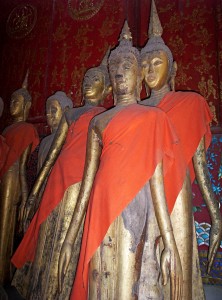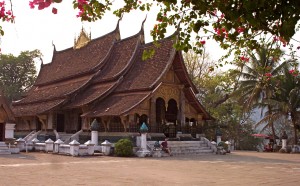 It’s gilded profile stands between two great, rushing rivers in the northern reaches of Laos. With its numerous historic temples, aging French colonial facades, UNESCO Heritage status and long, noble past, the peninsular village of Luang Prabang is a popular destination for culture vultures. This former capital of the ancient Lane Xang Kingdom is arguably one of the best preserved cities in Southeast Asia.
It’s gilded profile stands between two great, rushing rivers in the northern reaches of Laos. With its numerous historic temples, aging French colonial facades, UNESCO Heritage status and long, noble past, the peninsular village of Luang Prabang is a popular destination for culture vultures. This former capital of the ancient Lane Xang Kingdom is arguably one of the best preserved cities in Southeast Asia.
The Lao people are said to have first entered this river valley via southern China in the middle of the 8th century. Buddhism spread through the region several centuries later, thriving alongside ancient spirit worship practices. The mix resulted in a serene and affable people in-tuned with their environment and devoted to their simple, religious ways.
Legend tells the story of Fa Ngum, a Lao warrior who captured the town in the 14th century, founding a Kingdom called Lane Xang Hom Khao: The Land of a Million Elephants and the White Parasol. This renaissance period brought with it Theravada-style Buddhism, artisans, Khmer scholars and even a legal code. Temples, poetry and dance flourished during Fa Gnum’s reign, with a line of monarchs to follow him for the next six centuries.
Today, Luang Prabang is a picturesque town set amidst steep mountains and the great Mekong River. The French colonial years have left their mark, with outstanding cuisine, fine wines, and delightful old villas set along cobbled lanes. The town’s crisscrossing streets and alleys are lined with gilded Buddhist temples, colonial architecture and chi-chi cafes.
Home to numerous historic buildings and temples, the village was designated a World Heritage site in 1995. It has been undergoing refurbishment ever since with the help of $50 million dollars in aid from France, the European Union and UNESCO. There are now 642 protected sites in the three-lane peninsula that makes up the oldest part of the village. The list includes more than 30 temple complexes (wats), some dating back to Fa Gnum’s time.
 Luang Prabang is in fact, a village of temples, and visiting a few during your stay is a must. In this deeply Buddhist nation these wats, as well as the many monks who reside within their compounds, are the threads from which the Lao cultural fabric is woven. The Northern Laos style temple is distinct, with gracefully arched roof lines and fine ornamental detail. Lao people are fond of saying that their monastery roofs resemble the wings of a mother hen guarding her chicks. Coming to a sharp point at the top, they sweep down dramatically in great curves toward the ground. It is an elegant shape that evokes both movement and solidity.
Luang Prabang is in fact, a village of temples, and visiting a few during your stay is a must. In this deeply Buddhist nation these wats, as well as the many monks who reside within their compounds, are the threads from which the Lao cultural fabric is woven. The Northern Laos style temple is distinct, with gracefully arched roof lines and fine ornamental detail. Lao people are fond of saying that their monastery roofs resemble the wings of a mother hen guarding her chicks. Coming to a sharp point at the top, they sweep down dramatically in great curves toward the ground. It is an elegant shape that evokes both movement and solidity.
Many of Luang Prabang’s wats are painted a deep red with gold-leaf stenciled motifs of vines, flowers and Kinnaris. A mythic creature, the half woman-half bird Kinnari stands guardian beside windows and doors with her long, slender neck, delicate features and crowned head.
Wat Xieng Thong may be the best example of this architectural grace. This 16th century complex boasts a magnificent roof line, beautifully stenciled walls and a brilliant, tree of life mosaic made of colored mirrors, (under which at least one man I know proposed to his future bride).
Luang Prabang many monks are a popular tourist draw. Early each morning they begin their procession up the town’s main street. Barefoot and silent, their line stretches as far and farther than the eye can see, passing villagers ready to offer food and other gifts. But the monks aren’t ‘begging’ in any sense of the word, they’re performing a service. By allowing the community to give them food and other gifts, monks provide people with the opportunity to “make merit” (build credit) toward future lives.
Beyond the town, a popular excursion is a boat journey upriver to the Pak Ou Caves. Located one and a half hours north of the peninsula along the Ou River, the caves house some 4,000 Buddha images. The two caverns perched high on a cliff along the western bank of the Ou are a historic pilgrimage site. The entrance of the lower cave is the most obvious feature as you near the towering crag. A great white wall and a series stairs leading up to the mouth stand stark against the rich reds and browns of the rock face. The upper cave is reached by climbing an alternative set of steps, bringing you some 60 meters above the river.
Each spring the faithful clean the lower cave’s many shrines, and worshippers bring their personal Buddha images to be washed in the waters that emerge from its natural spring. A plaque at the entrance of the upper fissure indicates that restoration work was done in 1932, while in 1992, with the help of the Australian government, the Laos government began a five year conservation project that recorded and cataloged all of the sculptures within both caves.
While temple strolls, boat rides and low-key spelunking are the most popular activities, other day fun trips include the Kuang Si waterfalls, located 35 km southwest of town; a climb up the town’s steep, Phou Si Hill for expansive views of the entire river valley; a visit to the old royal palace – now a museum – filled with regalia and historic artifacts from the old monarchy; handicraft shopping at the evening street market run by the Hmong people; and relaxed meals in one of the town’s stylish cafes.
Whatever you fancy, at its best Luang Prabang is a peaceful retreat, a place to slow down, enjoy fresh mountain air, explore history, and revel in nature and delicious cuisine.

1 comment for “What to see in Luang Prabang”